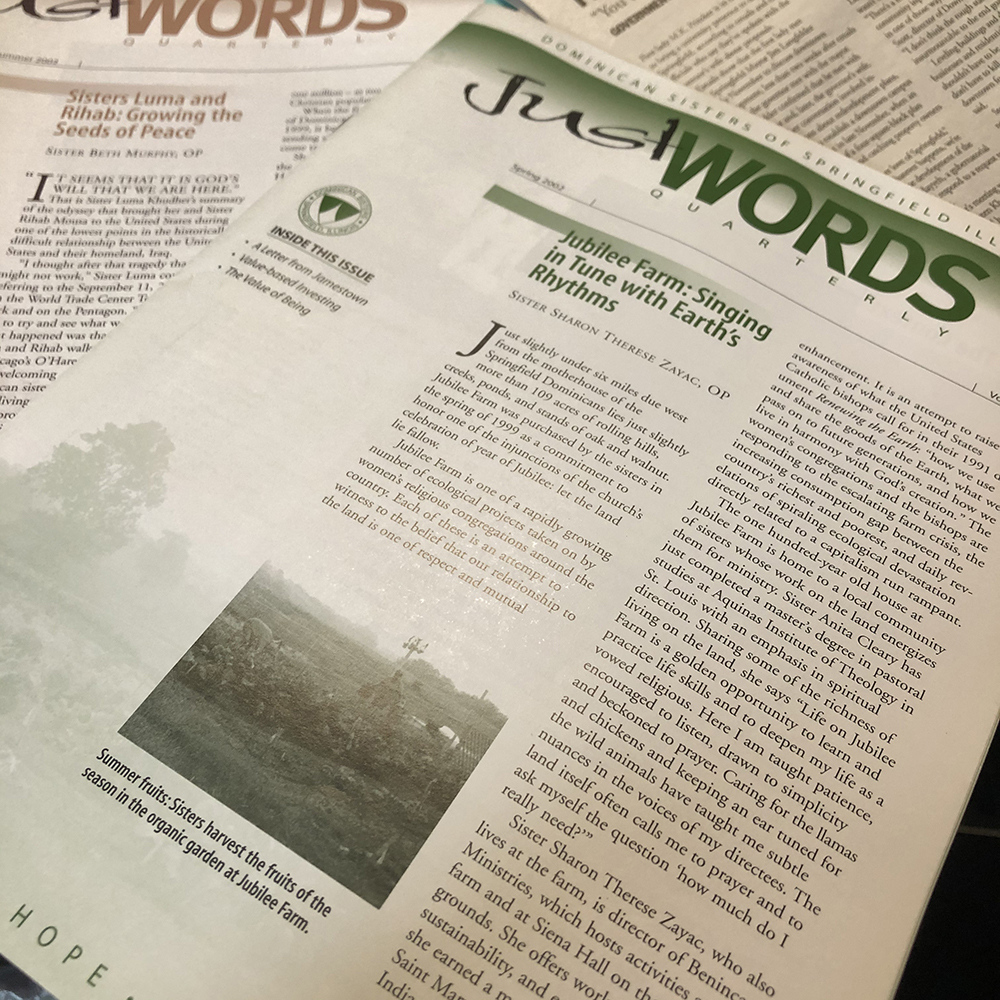
Just slightly under six miles due west from the motherhouse of the Springfield Dominicans lies just slightly more than 109 acres of rolling hills, creeks, ponds, and stands of oak and walnut. Jubilee Farm was purchased by the sisters in the spring of 1999 as a commitment to honor one of the injunctions of the church’s celebration of year of Jubilee: let the land lie fallow.
Jubilee Farm is one of a rapidly growing number of ecological projects taken on by women’s religious congregations around the country. Each of these is an attempt to witness to the belief that our relationship to the land is one of respect and mutual enhancement. It is an attempt to raise awareness of what the United States Catholic bishops call for in their 1991 document Renewing the Earth: “how we use and share the goods of the Earth, what we pass on to future generations, and how we live in harmony with God’s creation.” The women’s congregations and the bishops are responding to the escalating farm crisis, the increasing consumption gap between the country’s richest and poorest, and daily revelations of spiraling ecological devastation directly related to a capitalism run rampant.
A "golden opportunity"
The one hundred-year old house at Jubilee Farm is home to a local community of sisters whose work on the land energizes them for ministry. Sister Anita Cleary has just completed a master’s degree in pastoral studies at Aquinas Institute of Theology in St. Louis with an emphasis in spiritual direction. Sharing some of the richness of living on the land, she says “Life on Jubilee Farm is a golden opportunity to learn and practice life skills and to deepen my life as a vowed religious. Here I am taught patience, encouraged to listen, drawn to complicity and beckoned to prayer. Caring for the llamas and chickens and keeping an ear tuned for the wild animals have taught me subtle nuances in the voices of my directees. The land itself often calls me to prayer and to ask myself the question “How much do I really need?”
Sister Sharon Therese Zayac, who also lives at the farm, is director of Benincasa Ministries, which hosts activities at the farm and at Siena Hall on the motherhouse grounds. She offers workshops on ecology, sustainability, and eco-spirituality. Last year she earned a master’s in Earth Literacy from Saint Mary-of-the-Woods College in Indiana. The old farmhouse also doubles as an Earth Literacy Resource Center, where books, videos, and related materials may be read, discussed, or checked out.
Other farm residents include chickens, barn cats, and four llamas living in and around an ancient barn. In one corner of the barn is an art studio for Sister Mary Fran Gorman. She is often at work throwing clay, firing up the kiln, or painting an assortment of intricate figures, teapots, plaques, and urns. The barn cats and llamas are often curious about her creations.
The barn’s south side provides one of the walls for the small chicken yard; its north side faces the llama paddock. The chickens and llamas are important members of the farm community. Besides supervising Sister Mary Fran’s work, they donate their protein-rich manure for the organic vegetable and herb gardens. And their presence is often a key to snaring the attention of visitors, who then learn more about the farm’s ministry and purpose.
Visitors welcome
Visitors are always welcome to come walk the land. The three pasture trails are a call to prayer. They offer a silence rarely heard in the city. Benches scattered along the trail and around the ponds allow restful moments to savor the sounds of the pasture inhabitants, to enjoy the touch of the breezes and relish Earth’s rich scents.
In an area that will eventually become an organic orchard, an outdoor labyrinth is under construction. This ancient meditative prayer form offers a gentle walk through the orchard grass as the pray-er settles into the rhythm of the movement around the circuitous path. The labyrinth’s design is based on one embedded in the floor of the Cathedral of Notre Dame in Chartres, France.
Future dreams include the building of two small hermitages in the pasture area, offering quiet time for those drawn to solitude and prayer. They include a schedule of programs and experiences that offer the opportunity for adults and children to either reconnect with the land or come to know it for the first time. They include the hope that all visitors will come to understand that the Earth and all Earth’s creatures are one community, totally dependent upon each other’s health and well-being, and totally reflective of the God whose incredible love has brought it all into being.
First published in JUST Words, Vol. 2. No. 2, Spring 2002.

